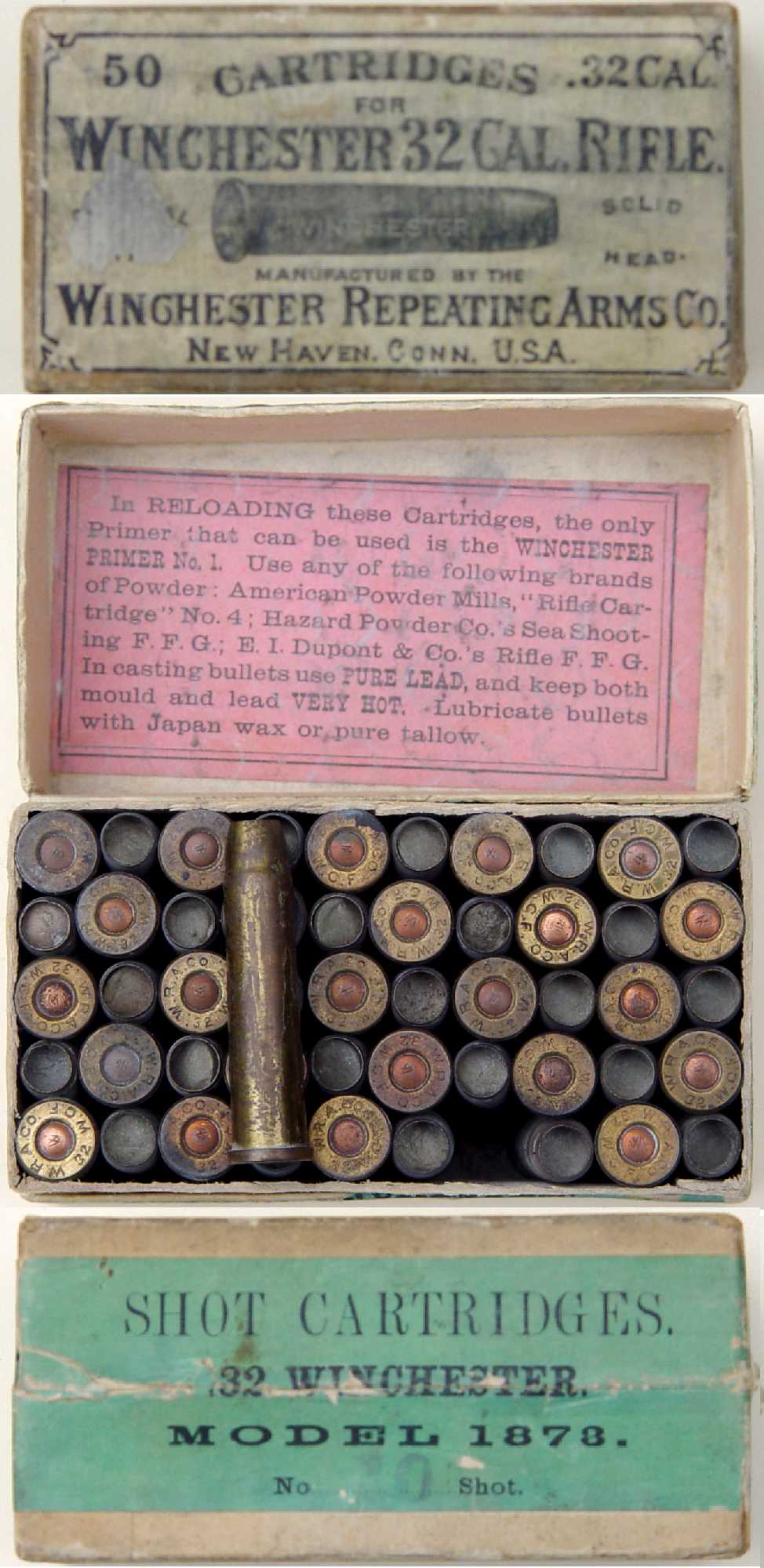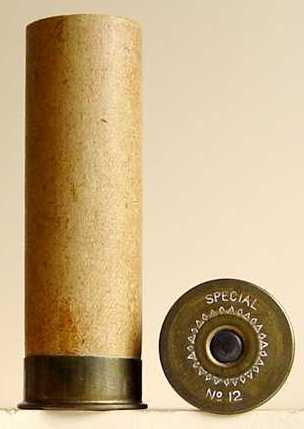|
THE CARTRIDGE COLLECTOR'S EXCHANGE |
| Contents
Cartridge
Lists
Prior Picture Pages:
Links to Other Sites
Cartridge Collectors Organizations:
Auctions:
Books:
Other Collector's Sites: |
Home of the Old Ammo Guy's Virtual
Cartridge Trading Table Featuring a wide range of antique, obsolete, and modern ammunition for collectors Picture Page July 2007 An unusual Winchester box.......
This box of .32-20 WCF shot cartridges was probably made during the 1880s, but could have been made as late as 1898. The nearly worn off 'Central Fire' to the left of the cartridge on the label was used until 1898, when it was changed to 'Center Fire'. The top and side labels do not mention the type of powder used, however, the the reloading information label inside the top recommends three brands of black powder to be used. Smokeless powder was first loaded by Winchester beginning in the mid-1890s. The boxes of smokeless cartridges would have likely listed the Model 1873 and 1892 rifles on the side label. The black powder .32-20 side labels such as this one list only the Model 1873 rifle; this one also indicates that the cartridges are loaded with No.10 shot. The cartridge cases are longer than the standard .32-20 case, measuring 1.690" compared with the usual 1.315". The extra length was needed to fit what was considered to be an effective shot load, 185 of the tiny (.070") #10 shot in over the powder charge. That I was willing to count the shot does not indicate that I have too much time on my hands; instead, I believe it is an indication of my boundless curiosity. As the primers on the cartridges in the box are marked with a 'W', I do not believe they are original to the box. . . . American Buckle & Cartridge Company shotshells...
The American Buckle & Cartridge Company was established in West Haven, Connecticut around 1885, manufacturing shotgun shells under a patent they received on March 3, 1885 that covered both the process and machines used in the production of their shells. In mid-1889, they were bought out by the Ammunition Manufacturers Association, a monopolistic corporation formed by Winchester Repeating Arms Company, Union Metallic Cartridge Company, the United States Cartridge Company, and Phoenix Metallic Cartridge Company for the purpose of controlling the prices of ammunition and cartridge loading components. Just prior to the sale, the Peters Cartridge Company, which was incorporated in 1887, had been in negotiations with the American Buckle & Cartridge Company to produce loaded shotshells for them. Following the sale, thenAmerican Buckle & Cartridge Company, who had retained their patents, sold them and two sets of machinery to Peters, giving them the ability to produce their own shotgun shells rather than having to buy them from the Association. Winchester brought suit against Peters in 1892, alleging that one of the machines purchased by Peters infringed on a Winchester patent. The suit, which Winchester won, was not settled until 1900. The SPECIAL No 12 shell shown above was made by the American Buckle &
Cartridge Company. Production
of these shells was limited, and they are not often encountered. I have never
seen one of these that was factory loaded, nor have I seen one in a size
other than 12 gauge. However, they did produce 10 gauge shells, so I would
be surprised if the Special shells were not also produced in both gauges. Several years ago, I purchased the Peters "Special'
10 gauge shotshell box shown below with a group of reloading tools
and supplies that had been found in Hannibal, Missouri by an antique picker.
The box is quite rare, being the only one like it that has surfaced that I
am aware of. The shell illustrated on the label used a method of c The relationship Peters had with the American Buckle & Cartridge Company during its early years leads me to believe that there is a connection between the 'Special' shells and this Peters 'Special' box. It is interesting to note that this is a generic headstamp, without the makers name, which does suggest that it was not made for sale under the American Buckle & Cartridge Company name. Another line of this company's shells was headstamped 'QUICK SHOT'; the name is likely a reference to King's Quick Shot semi-smokeless powder. These shells have the same circle of alternating diamonds and triangles around the primer as the Special shells. Peters used this powder, and for a short time produced rimfire and centerfire cartridges and shotgun shells under the brand name Quick Shot. I can't imagine who else other than Peters the Quick Shot shells would have been produced for. I don't believe Kings Powder Company loaded shells, and Peters is the only other company I'm aware of that used the name. If anyone can shed some light on the Special shotshell box and its possible connection to the American Buckle & Cartridge Company Special shells, as well as on a possible connection between Peters and the Quick Shot shells made by the American Buckle & Cartridge Company, I'd appreciate hearing from them. . . An sampling of Pedersen device variations.....
. . . . . . . . The picture above shows all of the .30 Pedersen cartridges from my collection. These cartridges were intended for an attachment designed for use with altered M1903 and M1917 rifles to convert them to automatic weapons. Approximately 65,000 of the Pedersen devices and 65 million rounds of the ammunition were produced, but not in time for use during the WW1. The headstamps that are most commonly found are on the third through sixth cartridges from the left, reflecting manufacture at the Bridgeport (#3 and #5) or Hoboken (#4 and #6) plants of Remington-UMC in 1918 or 1919. The headstamp on #1 is a tough one to find, and shows the lengths the company would go to ensure their clandestine production of these cartridges would not attract any unwanted attention. Another of these duplicitous headstamps to look for is REM-UMC 9m/m BS. I assume the RA headstamp with no date was an error, as there shouldn't be any practical reason to exclude the date. The seventh cartridge in a not too common variation with a heavier bullet, 90 grains rather than the standard 80 grains. The bullet is not seated so deeply in the case to allow greater powder capacity, a result of Pedersen's efforts to extend the effective range of his device. This same cartridge, loaded with a tinned bullet, was produced for use in an experimental Browning automatic rifle, beginning in 1919, and was referred to as .30-18 Automatic. Work on the rifle continued into the mid-1920s. Because of its similarity to the French 7.65 long automatic pistol cartridge, there is some speculation that the Browning automatic rifle cartridge was the basis for the French cartridge. The Pederson devices and ammunition were ordered destroyed in 1931, but because the cartridges are encountered so often leads me to believe that large quantities of the boxes of ammunition managed to find their way into private hands, along with a few of the devices, before it was decided to destroy them or perhaps even during the destruction process. . . . |



 rimping
that involved making three cuts in the case wall at the upper edge of the
wads and pushing the paper above the cut inward to hold the wads in place.
This method of crimping was used by Peter's on their shells beginning in
about 1888, based on the advertisements that can be found in period sporting
magazines. This crimping method was discontinued within a year or so,
probably due to the damage to the hulls that resulted from the indentations
tearing out when the shells were fired, rendering the shells unusable for
reloading. During the first few years after it started operations, Peters
loaded shells that were purchased from the members of the Ammunition
Manufacturers Association, and which bore the manufacturers' headstamps.
They obtained their powder from the King Powder Company. It didn't take long
for the heavy handed tactics of the Association to cause them to look at
alternative sources for the other components needed to load their shells,
and they were soon making
their own shot, primers and shells.
rimping
that involved making three cuts in the case wall at the upper edge of the
wads and pushing the paper above the cut inward to hold the wads in place.
This method of crimping was used by Peter's on their shells beginning in
about 1888, based on the advertisements that can be found in period sporting
magazines. This crimping method was discontinued within a year or so,
probably due to the damage to the hulls that resulted from the indentations
tearing out when the shells were fired, rendering the shells unusable for
reloading. During the first few years after it started operations, Peters
loaded shells that were purchased from the members of the Ammunition
Manufacturers Association, and which bore the manufacturers' headstamps.
They obtained their powder from the King Powder Company. It didn't take long
for the heavy handed tactics of the Association to cause them to look at
alternative sources for the other components needed to load their shells,
and they were soon making
their own shot, primers and shells.